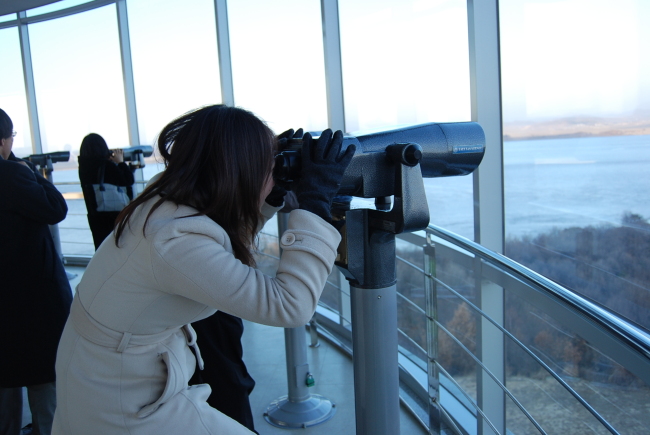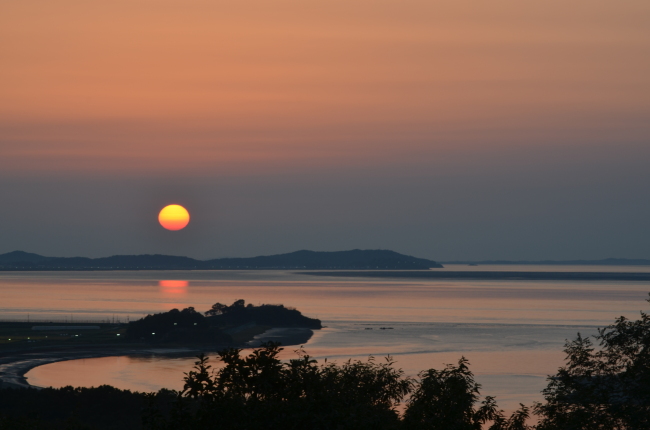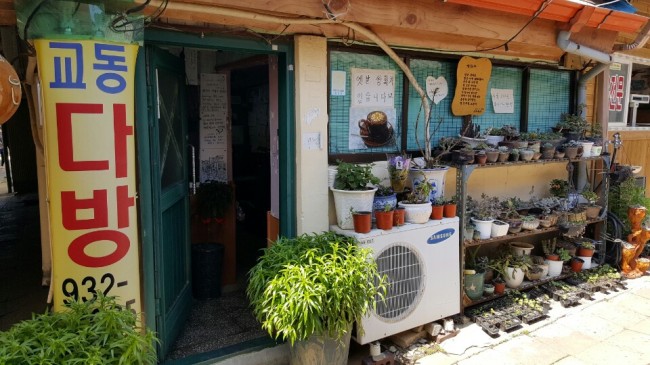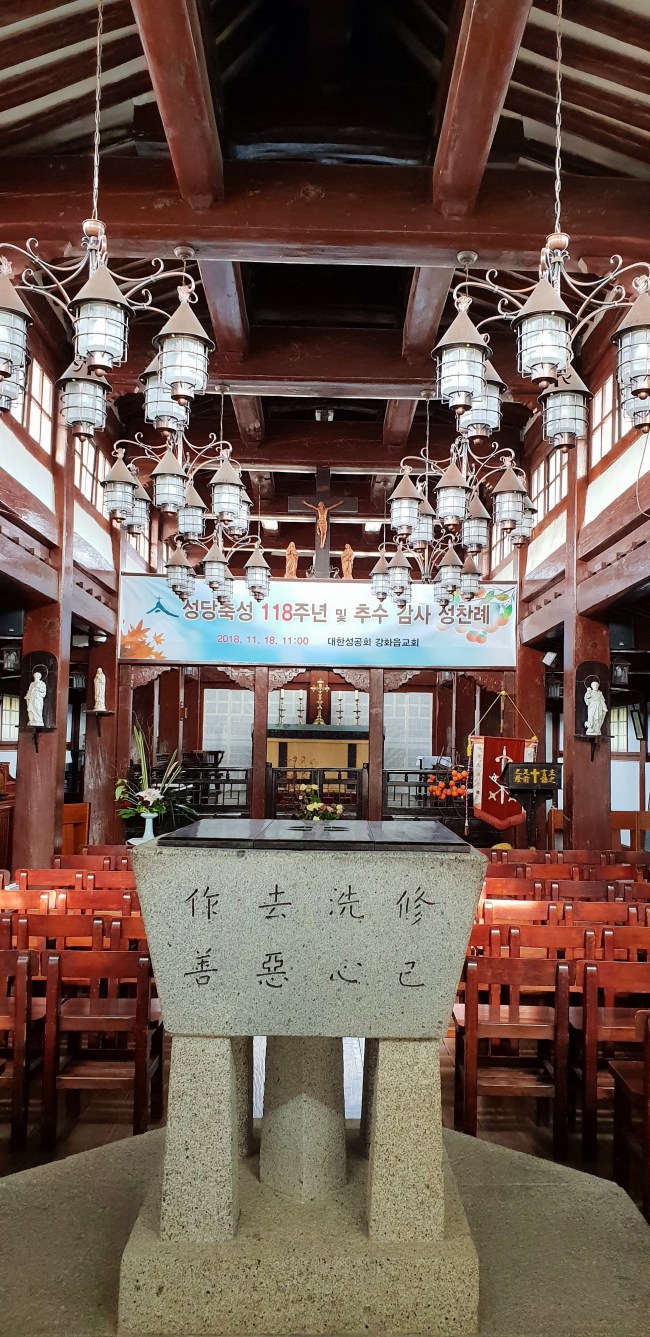Standing atop the Ganghwa Peace Observatory and looking over at the farmland of the most reclusive state in the world unfold in front of my eyes was a strange feeling. In my short days as a travel writer, I’ve literally been to the other side of the planet, yet there was always one place I could never be as a South Korean.
That’s North Korea. The “stone’s throw” cliche is only a slight exaggeration – the North Korean shore is just 2.3 km away. That’s how close it had been all this time.
Tantalizingly close 
A tourist looks into binoculars at the Ganghwa Peace Observatory. / Incheon Tourism Organization
The observatory is located in Yangsa-myeon, Ganghwa-gun in the city of Incheon, and requires an admission fee of between 2,500 won ($2.2) to 1,000 won. Four floors high, the building was built in 2008 as a symbol of hope for reunification between the Koreas.
The top floor has coin-operated binoculars. I popped in 500 won to look a little bit closer at Haechang-ri and Samdal-ri in North Korea’s Gaepung-gun. From the observatory, I could see homes, apartments, what seemed to be North Korean military facilities and even a glimpse of North Korean people going through their daily routines.
The sight was so mundane it felt so absurd. There they were, men and women living their lives so close to me, and the odds are I will never speak to them in my life.

A vew of North Korea from the Ganghwa Peace Observatory / Incheon Tourism Organization
It is located where two great rivers -- the Han River and the Imjin River -- meet, and I was told that it was even possible to catch a glimpse of Kaesong Industrial Park on a sunny day.
Visitors can also watch a video explaining what they are seeing on the other side of the river, which is only available in Korean.
Beware of what you take photos of. Being a border town, the observatory is right next to military facilities. While it is not against the law to look, it is illegal to take photos of them.
Also keep in mind that you are about to visit a place near North Korea, so there will be a military checkpoint that will check your ID and issue a visitor’s pass for you.
A short distance away from the observatory is Ganghwa Tourism Platform near Ganghwa Daeryong Market. Opened earlier this year, the building is designed after Goryeo celadon and woven cotton fabric, one of the products Ganghwa is famous for. VR programs provide a peak into the tourism spots and travelers can get guide booklets and coupons.
One feature was the “Bridge of Peace,” in which visitors can take photos that they can lay like bricks on a virtual bridge that connects the two Koreas. The thing is, no matter how many photos there are, it always appears to be just a few meters away from completion.
“The bridge can never actually be finished. It’s just a symbol to show our desire for unification,” said a staff at the visitors’ center. “I suppose when Koreas are unified, the bridge can finally be completed.”
It appeared to be a cruel reminder of how tantalizingly close -- yet impossibly far -- we were to connecting with long-lost kin.
Place of exchange
Back before there was a border dividing the Korean Peninsula into South and North Koreas, Ganghwa-gun was famous as a place of exchange. Ganghwa still has traces of that exchange, from a textile factory that was built by technicians in Kaesong to Ganghwa Ginseng, which originated from the now-North Korean city.
The tiny island of Gyodongdo is where many North Koreans who lost homes during the 1950-53 Korean War decided to settle and call home, in hopes that unification was just around the corner. The refugees became merchants, forming what is now known as Daeryong Market and dreaming of one day trading with their neighbors they left behind, just three kilometers away.
Daeryong is now both simultaneously a market and a tourist attraction, with its 1960s and 1970s theme. Slogans encouraging the citizens to work hard can be found across the town along with retro murals. Retro-style theater, barber shop, “dabang” -- what they used to call coffee houses -- and a photo studio transport you to a bygone era.

Daeryong Market / Incheon Tourism Organization
You can actually rent 1970s school uniforms and dress up for black and white photos.
Detour into the past
Ganghwa Anglican Cathedral / Incheon Tourism Organization
Ganghwa Anglican Cathedral, located in Gwancheon-ri, Ganghwa-eup, dates back to 1900, four years after the first Korean was baptized. It is currently the oldest cathedral in Korea in the style of a hanok, or traditional Korean building.
The structure is traditional Korean, but the interior is designed in Western style. It still holds weekly masses for local believers.
About 10 minutes’ walk from Ganghwa Tourism Platform lies old palace grounds from Goryeo.
The capital city of the ancient kingdom, which lasted from 918-1392, was in Kaesong, but the county of Ganghwa hosted the royals for 39 years during a Mongolian invasion in the 13th century. The palace and its walls were torn down after the country signed a peace treaty with the Mongols, but some traces of the ancient buildings remain. Ganghwa remained an important strategic point throughout the Joseon years, and still is.
(
minsikyoon@herldcorp.com)









![[KH Explains] Hyundai's full hybrid edge to pay off amid slow transition to pure EVs](http://res.heraldm.com/phpwas/restmb_idxmake.php?idx=645&simg=/content/image/2024/04/18/20240418050645_0.jpg&u=20240419100350)